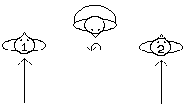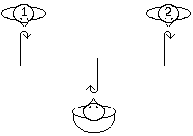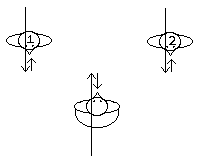Starting Position

Section I, Bars 7-8

Section II, Bars 1-2

Section III, Bars 1-3

Bar 9 (2nd time) Start of Hey

End of Hey
| Steps: | Sempio (in 4), Doppio (in 4), Piva (in 4), Continenza (in 4), Ripresa (in 4), Reverenza, Mezavolta, Voltatonda, Hey. | Starting Position |
| Start: | Three people side by side, facing up the hall, not holding hands. The person in the middle (called Center in the notes below) is of one gender and the other dancers (called Sides in the notes below, with Side 1 on the left and Side 2 on the right) are of the other gender. (In the diagrams, the center person is a woman.) |  Section I, Bars 7-8 |
| [Two-bar introduction on accompanying tape.] | ||
| 1-2 | Doppio Left, Doppio Right ending with a Mezavolta Left. |  Section II, Bars 1-2 |
| 3-4 | Doppio Left, Doppio Right ending with a Mezavolta Left. (Dancers are back exactly as they started.) | |
| 5-6 | Center Sempio Left, Sempio Right, Doppio Left, and Step Right on last beat. | |
| 7-8 | Sides Sempio Right, Sempio Left, Doppio Right, | |
| as | Center ends with a Mezavolta Right. (Center is facing down the hall, a step in front of Sides, who are facing up.) |  Section III, Bars 1-3 |
| 1-2 | Doppio Left, Doppio Right, ending with a Mezavolta Right. (Center is facing up the hall, about 11 steps from Sides, who are facing down.) | |
| 3-4 | Ripresa Left, Ripresa Right. | |
| 5-6 | Voltatonda (Doppio Left in a counterclockwise half circle, ending with a Mezavolta Left, and Ripresa Right). | |
| 7-8 | Continenze Left, Right, Left, Right. | |
| 1-2 | Sempio Left, Sempio Right, Doppio Left, to come together. |  Bar 9 (2nd time) Start of Hey |
| 3 | Doppio Right backwards, using half-sized steps. (Center is facing up the hall, about 4 steps from Sides, who are facing down.) | |
| 4 | Reverenza Left. | |
| 5-8 | Voltatonda and 4 Continenze, as in Section II | |
| 9-12 | Center and Side 2 (the one to Center's right) take right hands and circle each other with 4 Pive, starting Left. |  End of Hey |
| 13-16 | Center and Side 1 take Left hands, and circle each other with 4 Pive, starting Left. | |
| 9-16 (2nd time) | 8 Pive, starting Left, doing a Hey, Center and Side 2 starting by passing right shoulders. Center ends between Sides, and turns to face down the hall. (Dancers are now together, Side 2 on the left, facing down the hall.) | |
Recordings
Bel Danzare - ("Rossina") Two-bar introduction, dance starts with drums. Works with this reconstruction. Repeats.
Danzare - ("Rossina") Drum introduction. Works with this reconstruction. Repeats.
Forse - Very, very long introduction (over a minute). Section IV is played a little differently (the first four bars are repeated three times, and then the last four bars are played once) but the same number of bars result, so it works with this reconstruction. Repeats.
Mesura - Four-bar introduction. Section IV is repeated four times, and played very fast, so each piva should take two bars. Repeats.
Dance Notes
There are two sources for this dance, Rossina in NYp, and Voltati in Ca Rosina in PnA. The two are obviously the same dance, but are sufficiently different that it would be impossible to form a reconstruction that is true to both. Rather than attempting to bring together the two sources as much as possible, or using one of the sources more than the other, this reconstruction attempts to produce an easier dance. In order to do this the dance was made more regular, most notably by moving the reverenza of the third section earlier than the voltatonda, so that Bars 5-8 in Sections II and III become an identical, chorus-like sequence. Although repetitive choruses were appearing late in this period, such as in the dance Vita di Cholino, this chorus is an artificial addition to the dance. As well, without this change the third section has a voltatonda in Bars 4 and 5. The music for this piece is very regular, having clear, two-bar phrases, and it feels awkward to dance the voltatonda half in the phrase of Bars 3-4, and half in another phrase in Bars 5-6. That the figure was unsynchronized with the phrases may have been intentional in the original choreography, so, while this change makes the dance easier for twentieth-century people to do, it ignores what may have been an admired effect in the fifteenth century.
The division between the second and third sections is also very unclear in the sources. We decided to have the third section start with the two sempii forward, but this is based on the presumption that the two sempii and the doppio are a unit that should come together in one musical phrase. A strict reading of both sources could lead to them being split between the second and third repeats of the music.
Section I:
Bar 1: No starting foot is given, but the left is usual. There are many places in the dance where the foot is not given, but in each case the foot chosen in the reconstruction seems to be the obvious choice.
Bars 1-4: NYp says to do doppii with mezeriprese, while PnA calls for doppii in quadernaria. Using saltarelli tedesci would probably be more accurate, and can be used instead, but this reconstruction uses unornamented doppii for simplicity.
Bars 3-4: PnA says to do a voltatonda with two doppii, while NYp has the dancers turn around and return to their starting places. The two movements are quite similar, but the NYp version was chosen as more repetitive and so (we hope) easier to remember. It is quite possible that the two sources are describing the same action in different ways.
Bar 6, last beat: NYp instructs the center dancer to put the right foot forward, which we have interpreted as a step. This enables the dancer to pivot on the right foot, and then step on the left foot at the beginning of Section II.
Section II:
Bars 1-2: In PnA these are given as saltarelli, while in NYp they are doppii. Again, this may mean that they are saltarelli tedesci, but we chose unornamented doppii. Saltarelli tedesci can replace them.
Bars 5-6: The voltatonda is actually described in both sources as being done with only one doppio. This, however, would produce only seven bars of dance for the eight bars of music in this section. The voltatonda in Section III is followed by a ripresa, so we decided to use this same sequence here.
Bars 7-8: NYp has a continenza and a riverenza picina where PnA has four continenze.
Section III:
We have primarily used PnA for this section. The dance in NYp is quite different, starting with the same two sempii and the doppio, then continuing with three passitti backwards (equivalent to the doppio backwards in PnA), a turning doppio, ripresa, a continenza (presumably meaning two of them), a turning doppio, a ripresa, a reverenza, two continenze, and a turning doppio. This would take eleven bars, rather than the eight bars of music available. However, it is possible that some of these steps should actually appear in the previous section, making the two dances quite dissimilar.
Bar 2: In NYp there is a reverenza picina here, presumably a short reverenza on the fourth beat. This can be added in. If teaching a beginning class, we suggest that the teacher do it without actually teaching it, as the students will often pick it up with less trouble than if they have to remember it.
Bar 3: No mention is made of the steps of the doppio being small, although NYp does refer to them as tre passetti rather than a doppio. We decided on small steps here to keep the dancers close enough together to do the rest of the dance more easily. Backing up is also less dangerous with small-sized steps.
Bars 4-6: In PnA the voltatonda occurs before the reverenza, while the corresponding section in NYp is the part that matches least well, but there is also a voltatonda earlier than the reverenza. This change was made to make the dance easier, as Bars 5-8 are now identical to the same bars in Section II.
Bars 5-6: In PnA the voltatonda is not described but is followed by a ripresa; NYp has a similar figure, giving a turning doppio followed by a ripresa. The ripresa is incorporated as part of the voltatonda as without it the ripresa will move people out of line with each other. This may have been understood, in the same way that the ripresa in the volta del gioioso seems to be understood to be part of it although often described as occurring after it.
Section IV:
PnA is the only source for the music, and specifies that this section is only played once, but it is clear from the dance that more than eight bars of pive are required. NYp calls for sixteen bars, so we decided to repeat the last section of music.
Bar 5: No starting direction is given for the hey. The choice made results in the dancers starting in the same directions as they just did in Bars 9-16 (1st time), which we think is easier to remember.
Bars 5-8: PnA describes this section as "vagano in piva Ala guisa d'un bissia", adding that the center dancer returns to the middle, while NYp says they "facino un'aspinapescie chon otto tenpi di piva", with the side dancers changing places. This figure is presumed to be a hey, and eight pive is easily enough to do a full hey, bringing everyone back to place. Since NYp also includes the instruction that the dance is to be repeated, it makes sense to have the dancers perform a full hey, but the sides to "change" places by having the set face the other way (by having the center dancer turn around) at the end.
Repeat: NYp calls for a repeat, while PnA does not. We chose to have one as at the end of a repeat, in our reconstruction, the dancers will have returned to their original positioning.
Music Notes

We made two changes to the music. First, we added a repetition of Section IV to match the dance. Second, we added the first eighth note in Bar 3, which was missing in the original. (We modelled that bar on Bar 1, as this one is otherwise identical to it.)